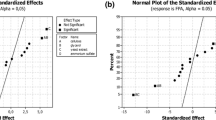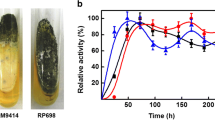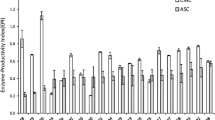Summary
A model is proposed for the enzyme production by Trichoderma reesei (QM 9414), which assumes control of the active enzyme transport through the cell membrane as a key parameter for the enzyme activity change in the culture filtrate. In a stirred tank reactor, continuous cultivation of the fungus was carried out in the dilution rate range of D=0.01–0.032 h−1. After changing the dilution rate it took 3–4 weeks to attain a steady state in enzyme activity. Reducing sugars, dissolved protein, enzyme activity (filter-paper and glucosidase activities), cellulose and nitrogen content of the sediment, the elementary analysis of the cell and the composition of the outlet gas were all determined during cultivation. At a dilution rate of D=0.025 h−1 all of these properties change due to derepression (for D<0.025 h−1) or repression (for D>0.025 h−1) of the enzymes which are responsible for the active transport of cellulases from the cell into the medium. The cellulase excretion causes a decrease of the yield coefficient of growth and a reduction of the nitrogen content of the cells.
In a two-stage system the time to attain a steady state increases to 4–6 weeks. At low dilution rates the enzyme activity is only slightly higher in the second stage than in the first. At high dilution rates, at which the enzyme is not excreted into the medium in the first stage, enzyme activity can be increased considerably in the second stage.
Similar content being viewed by others
References
Andreotti R, Mandels M, Roche C (1977) Effect of some fermentation variables on growth and cellulase production by Trichoderma QM9414. Proc Bioconversion Symp IIT Delhi. pp 249–267
Bisaria VS, Ghose TK (1977) Sorption characteristics of cellulases on cellulosic substances. Proc Bioconversion Symp IIT Delhi, pp 155–164
Brown DE, Waliuzzaman M (1977) Kinetics of enzymatic hydrolysis of waste newspaper. Proc Bioconversion Symp IIT Delhi, pp 351–372
Brown DE, Zainudeen MA (1977) Growth kinetics and cellulase biosynthesis in the continuous culture of Trichoderma viride. Biotechnol Bioeng 19:941–958
Brown DE, Halstead DJ (1975) The effect of acid pH on the growth kinetics of Trichoderma viride. Biotechnol Bioeng 17:1199–1210
Enari TM, Markkanen P (1977) Production of cellulolytic enzymes by fungi. Adv Biochem Eng 5:1–23
Ghose TK, Sakai V (1979) Production of cellulases by Trichoderma reesei QM 9414 in fed-batch and continuous-flow culture with cell recycle. Biotechnol Bioeng 21:283–296
Ghose TK (1977) Cellulase biosynthesis and hydrolysis of cellulolytic substances. Adv Biochem Eng 6:39–76
Goa J (1953) Micro-Burette method for protein determination. Scand J Chim Lab Invest 5:218–222
Gong CS, Tsao GT (1979) Cellulase and biosynthesis regulation. Annual reports on fermentation processes, vol 3. Academic Press, New York, pp 111–140
König B, Lippert J, Schügerl K (1979) A steady state method for the determination of kLa values in stirred tank reactors. Oxygen transfer rate in model fermentation media with high speed stirrer. Ger Chem Eng 2:371–377
Kubicek CP (1981) Release of carboxymethyl-cellulase and β-glucosidase from cell walls of Trichoderma reesei. Eur J Appl Microbiol Biotechnol 13:226–231
Mandels M, Andreotti R (1976) Measurement of saccharifying cellulase. Biotechnol Bioeng Symp 6:21–33
Mandels M, Reese ET (1957) Introduction of cellulose in Trichoderma viride and influence by carbon sources and metal. J Bacteriol 73:269–278
Mandels M, Sternberg D, Andreotti R (1975) Growth and cellulase production by Trichoderma. SITRA Symp. Helsinki, pp 81–109
Mitra G, Wilke CR (1975) Continuous cellulase production. Biotechnol Bioeng 17:1–13
Nagai S, Onodera M, Aiba S (1976) Kinetics of extracellular cellulase and amylase production from Trichoderma sp. Eur J Appl Microbiol 3:9–18
Nystrom JM, Diluca PH (1977) Enhanced production of Trichoderma cellulase on high levels of cellulose in submerged culture. Proc Bioconversion Symp IIT. Delhi, pp 293–304
Nelson N (1944) A photometric adaptation of the Somgyi method for the determination of glucose. J Biol Chem 153:375–380
Peitersen N (1977) Continuous cultivation of Trichoderma viride on cellulose. Biotechnol Bioeng 19:337–348
Peitersen N, Ross EW (1979) Mathematical model for enzymatic hydrolysis and fermentation of cellulose by Trichoderma. Biotechnol Bioeng 21:997–1017
Ross A (1982) Die Produktion von Cellulasen mit Trichoderma reesei. Dissertation, University of Hannover
Ross A (1979) Versuche zur Cellulaseproduktion mit Trichoderma reesei QM 9414. Diploma thesis, University of Hannover
Ryu D, Andreotti R, Mandels M, Gallo B, Reese ET (1979) Studies on quantitative physologie of Trichoderma reesei with two-stage continuous culture for cellulase production. Biotechnol Bioeng 21:1887–1903
Sinner M, Simatupang MH, Dietrichs MH (1975) Automated quantitative analysis of wood carbohydrates by borate complex ion exchanged chromatography. Wood Sci Techn 9:307–322
Sinner M, Puls J (1978) A noncorrosive dye reagent for detection of reducing sugars in borate complex ion exchange chromatography. J Chromatogr 156:197–204
Sternberg D (1976) A method for increasing cellulase production by Trichoderma viride. Biotechnol Bioeng 18:1751–1760
Sternberg D, Dorval S (1979) Cellulase production and ammonia metabolism in Trichoderma reesei on high levels of cellulose. Biotechnol Bioeng 21:181–191
v Stockar U, Yang RD, Wilke CR (1977) Computation of the fraction of induced cells in enzyme induction systems. Biotechnol Bioeng 19:445–458
Su TM (1976) Comments on the papers presented at the cellulase production session. Biotechnol Bioeng Symp 6:83–89
Updegraff DM (1969) Semimicro determination of cellulose in biological materials. Anal Biochem 32:420–444
Vaheri MP, Vaheri MEO, Kauppinen VS (1979) Formation and release of cellulolytic enzymes turning growth of Trichoderma reesei on cellobiose and glycerol. Eur J Appl Microbiol Biotechnol 8:73–80
Wood TM (1968) Cellulolytic enzyme system of Trichoderma konigii. Biochem J 104:217–227
Author information
Authors and Affiliations
Rights and permissions
About this article
Cite this article
Ross, A., Schügerl, K. & Scheiding, W. Cellulase production by Trichoderma reesei . European J. Appl. Microbiol. Biotechnol. 18, 29–37 (1983). https://doi.org/10.1007/BF00508126
Received:
Issue Date:
DOI: https://doi.org/10.1007/BF00508126




